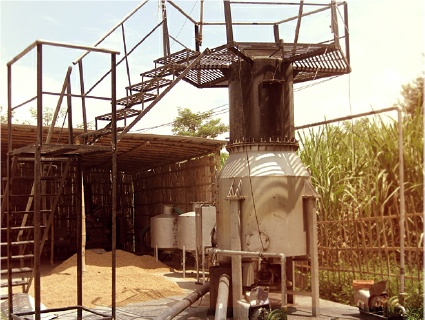In Bihar, one of the poorest states in India, 85 percent of people are not connected to the electricity grid so households use kerosene lamps when they can afford it and businesses use expensive and dirty diesel generators.
Some view this 'energy poverty' as a development problem, others view it as an environmental problem. The founders of Bihar-based Husk Power Systems view it as an opportunity to build a social enterprise.
Their motto is tamaso ma jyotir gamaya - ‘from darkness to light’
Husk Power Systems realized that one waste product in Bihar, rice husks, could be used to power a small biomass gasifier. Along with rice husks, they also use mustard stems, corncobs, grasses, and other agricultural residue. After five months of R&D, they developed a system that could produce 32 kilowatts of power by burning 50 kilograms of rice husk per hour. In the last four years, they’ve installed over 80 biomass mini-plants across Bihar, bringing power to more than 32,000 rural households.
This is just a fraction of the potential market. According to Salman Zafar, CEO of BioEnergy Consult and a renewable energy expert in India. The potential demand for biomass power generation in India exceeds 30,000 megawatts (MW); more than 1,000 times Husk Power’s current installed capacity.
Despite the large potential market, Husk has limited competition.
The Technology Is Just The BeginningThough it is not as clean as energy sources such as solar and wind, biomass power generation from rice husks and waste materials is still cleaner than fossil fuels or biofuels such as ethanol. Each of Husk’s mini-plants saves 125 to 150 tons of CO2per year as compared to a fossil-fuel powered plant. What’s more, plants become profitable within two to three months after installation.
Husk’s biomass generation technology is proprietary, but it is based on a decades-old gasifier system that uses a combination of rice husks and diesel fuel to generate power. These “dual fuel” systems were once used by rice millers to power their mills, but were not economically feasible for household electrification.
Credit: Husk Power Systems
Husk co-founder Gyanesh Pandey, working with Dr. S.K. Singh from India’s Ministry of New and Renewable Energy, re-imagined the antiquated system and developed a “single fuel” gasifier that’s designed for ease of operation and maintenance. It is “so simple that even a person who cannot read and write can operate it with a little bit of training,” says Husk co-founder Ratnesh Kumar.
The simplicity of the gasifier is just one way in which Husk has tailored its operations to address the challenges of profitably providing off-grid power to rural villages.
Now, the company is focused on its biggest challenge yet: “human capital.”
Creating A Professional WorkforceHusk has the ambitious goal of reaching 2,500 mini-power plants in the next five years. In order to reach its goal, it will need about 7,000 trained employees who are willing to work in rural India, an area that urban Indians call “the darkness.” Their motto is tamaso ma jyotir gamaya—“from darkness to light.”
In early 2011, Husk set up Husk Power University in partnership with the Shell Foundation and the International Finance Corporation (IFC). The university is a training program for mechanics and mid-level managers.
A power company does not have a core business to open a university, but it is essential for us to do it.
The university currently offers several different training programs. One three-month program teaches a rural villager with limited schooling how to operate a mini-plant. From this level, an operator can take additional courses to become an engineering mechanic. Promising engineering mechanics can train to become Husk-certified engineers, who oversee the operations of 30 – 40 plants.
Another training program develops cluster managers, who oversee 5 – 6 plants that are in close proximity. Cluster managers need to be able to successfully manage 15 – 20 employees.
Training a talented pool of cluster managers will create a pipeline of upper-level management talent to help the company scale efficiently and rapidly. Husk employs about 360 full-time staff, and plans to grow to nearly 20 times its current size in the next five years.
Funding Rapid GrowthIn tandem with the recruitment of thousands of employees, Husk will need to raise about $30 million in debt and equity capital, according to Sinha.
Identifying funders who are interested in a social enterprise that serves the rural poor is not easy. In 2009, Husk received a pre-Series A round of financing from Acumen Fund, Bamboo Finance, LGT Philanthropy, Draper Fisher Jurvetson, and the International Finance Corporation (IFC). Its ability to reach its five-year target will hinge on its success at attracting new funding sources.
Husk will also have to address the persistent misconception that people at the bottom of the pyramid are not willing to pay for electricity.
To do so, Husk will have to prove that its operating model works just as effectively in East Africa as it does in India.
Husk’s founders know Bihar well - one of them grew up in Bihar - but it’s unclear whether they will be able to operate successfully in Tanzania and Uganda, two planned expansion countries where they are not familiar with the local context.
Husk will also have to address the persistent misconception that people at the bottom of the pyramid are not willing to pay for electricity and prove that there is reliable demand for their product.
Their current operations have already convinced some investors. “Bihar is the poorest of the poorest states in India. These are the bottom of the bottom of the pyramid consumers. These consumers are not only willing but desperately able to pay for this service,” says Desjardins of the Shell Foundation.
Originally published on ecomagination.com. Republished with permission.






Comments